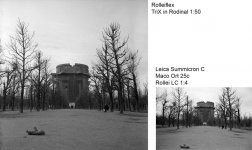J J Kapsberger
Well-known
Beautiful. Your Leica vs. Leica test captured the essence of the thread starter's comparison, which was between relative image sizes on the negatives/slides rather than absolute image size. A 6cm image of a face (i.e., the maximum uncropped size on a 6x6 negative) blown up to 16" (40cm) will look better (dare I say appear sharper?) than a 3.5cm image of a face (i.e., the maximum uncropped size on a 35mm negative) blown up to the same size. I expect there will be significantly greater cohesion (perhaps that's a more acceptable word?) in the enlargement of the 6x6 negative. Relative to the 35mm image, the 6x6 image has been defined by more grain, and the tightness of the grain has been eroded to a lesser degree during enlargement. The greater cohesion of the 6x6 shot would cause the image to appear sharper to the typical viewer.
WoolenMammoth said:frank beat me to it... This is pretty typical of big fish/little pond stuff where some guy has to be right all the time and does it by debating semantics. Its odd that you guys are entertaining that, everyone here seems pretty level headed, but Im pretty new here.
this discussion did a good job of addressing the original poster, bigger negative has more information (grain) per square mm than a smaller one, so if that doesnt yield a sharper or whatever damn word you want to use to identify information per square mm, you guys might be out to lunch.
You really shouldnt confuse the discussion with big words that are apparently disctracting like "medium format". Simply take your Leica with the best glass in the world or whatever fantasy you want to have about it, and go take a picture of a brick wall. Then take a whole bunch of steps back until your brick wall now only fills 1/3 or 1/4 of the frame and take a similarly framed photo to match your original camera position. Take those two frames, both shot with the worlds best camera and the worlds best glass and go develop them in your favorite developer. Next, print these two frames 11x14 on the exact type of paper, developed in the exact type of chemistry. Print the first full frame, print the second so that the brick wall fills the frame to match the framing of the first picture, using only 1/3 or 1/4 of the neg depending how you framed it.
Now argue about which print appears "sharper" viewed from 6 feet away. Or the color of the sky or how you pronounce the word "tomatoe", all three would amount to equally efficient and worthy discussions.
Just remember, if you continue to argue this you are arguing with someone who claims that (and will surely now begin to backpedal or distract with language) that "As to the rest (35mm vs. MF), negative quality per square millimetre, for example, has nothing to do with enlargement. These are completely different syllogisms." If this statement had any bearing on planet earth people wouldnt be caught dead hauling 70mm Imax cameras to the top of everest, they'd just shoot on super 16mm and let magus work his physics defying logic on their negs.




